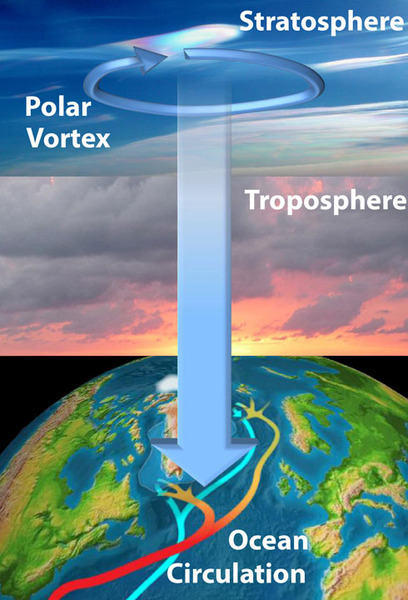
| 2012-09-25 06:56:27 |
Stratospheric Winds Churn Up the Abyss
from http://news.sciencemag.org/
High in the stratosphere, a vortex of winds is spinning, and that lofty swirling eddy might stir the ocean depths. New supercomputer simulations suggest that the stratospheric vortex of winds helps churn the oceans around the planet—and therefore also might help shape global climate, the researchers say.
Scientists knew that activity in the stratosphere 10 kilometers to 50 kilometers above Earth plays a role in what happens in the troposphere, the part of the atmosphere extending from the planet's surface to the stratosphere. They also knew the behavior of the troposphere influences the circulation patterns of the oceans, which, in turn, drive climate. Research reported earlier this year hinted thatevents in the stratosphere might directly affect the oceans, but those findings were based on a single climate model and a computer simulation that modeled the stratosphere for a relatively short 260 years.
To delve deeper into any stratosphere-oceans link, climate scientist Thomas Reichler of the University of Utah in Salt Lake City and his colleagues reexamined simulations from a well-known climate model developed by the National Oceanic and Atmospheric Administration that compiled 4000 years of atmospheric and ocean conditions, and compared these with weather and ocean data collected over the past 30 years. These revealed a surprising link between stratospheric winds and ocean currents as deep as 2 kilometers beneath the waves. The researchers report online today in Nature Geoscience that the findings from that climate model were supported with data from 18 other models.
Every 2 years on average, they found, the stratosphere suddenly warms by several tens of degrees Celsius. During these events, a polar vortex of up-to-130-kilometer-per-hour stratospheric winds encircling the Arctic can weaken or change direction (from counterclockwise to clockwise around the North Pole) for up to 2 months. The simulations suggest that over decades, these warming events dramatically perturb the ocean surface, affecting the flow of the Atlantic Meridional Overturning Circulation, a system of currents that acts like a conveyor belt moving water around the planet.
"The effects from the stratosphere can explain on the order of 30% of the oscillations we find in the ocean," Reichler says. "We found the Atlantic Meridional Overturning Circulation has an 'Achilles heel,' a vulnerable spot in the North Atlantic Ocean in the region south of Greenland." That region, he says, is susceptible to even small amounts of warming and cooling from the atmosphere—and how cold the water gets influences how much or how little it sinks, thereby driving or delaying, respectively, the ocean conveyer belt.
"I never considered that weather events tens of kilometers high in the atmosphere significantly influence the decadal- to century-scale circulation kilometers deep into the ocean," says climatologist Judah Cohen of Atmospheric and Environmental Research in Lexington, Massachusetts, who did not take part in this study. "This paper is another example of how surprisingly complex the climate system is, how interrelated or interconnected all the parts are, and how difficult it is to model correctly."
These findings suggest that climate models should perhaps not ignore the stratosphere as they often do. However, Reichler cautions that it remains unclear how important the stratosphere is to climate. The stratospheric sudden warming events analyzed in the paper are driven by air waves traveling upward from the troposphere—"so one could argue whether or not the troposphere is the primary cause of events," Reichler says. "I would say the stratosphere is still needed to amplify these effects from the troposphere to have an impact on the ocean, but I would like future research to really investigate this question."

